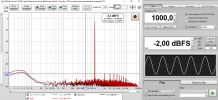Hi,
this is my first post but I have been reading along for a while.
Of course, as an owner of the 3080, I was very curious to see the results.
I know that some time ago another user posted SINAD results on this website that they measured at home, which were a bit better.
Unfortunately, I cannot find the link. If someone else remembers, please let me know. It was a comment in another thread (about a year ago - just the SINAD values). It might obviously have been a measurement mistake but it would be nice to compare and if I understood correctly, Gene measured a SINAD of 100dB on the newer one. There might be a few more elements that might be worth testing because - as is custom for Yamaha - it has tons of configuration options...
@amirm First off, thank you for this great site and all the effort that went into it.
Regarding this review, I was wondering about a few things that might impact the results - but please let me know if I am mistaken. I do not claim to be a Yamaha expert!
1) The receiver offers several DACs. By default, the worst one (according to Gene) called "short latency" is activated. What happens when choosing "sharp" (the best according to Gene)?
Does it make a change in the results when you switch it?
2) The Yamaha also offers jitter control, which can be configured with 3 levels - per default, the jitter is set to the worst performance (level 1).
3) I think the amps cannot be deactivated but what happens to the measurements via pre-out when using ECO mode - it seems unnecessary to run the amplifier at full power in this case and if the main problem really stems from the power supply, this might be a way to reduce its effect - although it might shut down even earlier (?!)
4) I admit that I don't know enough about the measurement protocols and apologize in advance, but I thought I would also point out that Yamaha seems to suggest using the Audio 2 and not Audio 1 line-in for music in their appendix of the instruction manual. Nevertheless, I assume that the test signal was provided digitally anyway.
It would be great to see if these elements have any effect. It would probably be minuscule but then again, so are the values that we are dealing with...

If there is a way for me to measure it myself, I am happy to do so with my 3080, but I do not have any special test equipment, other than a good external soundcard (Behringer) and a umik mic.
Of course, I am curiosity driven, as most people on this forum.
With my listening room having a background noise of >30dB, I have no illusions that whatever I am missing (or whatever noise this amplifier might add) will not be audible in my environment anyway... even if I had golden ears...

Thanks again!


